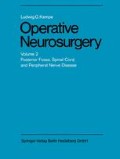Abstract
Since 1955 we have used the posterior fossa approach exclusively in the surgical treatment of tic douloureux. This exposure is preferable because, as Dandy 1 pointed out many years ago, light touch is preserved in all three divisions. This means that the corneal reflex is not disturbed. It would also seem that this is a less hazardous approach as far as injury to the motor root is concerned. Because tic douloureux may result from compression of the nerve roots by various causes, this route also offers the advantage, in these cases, of exposing the pathology.
Access this chapter
Tax calculation will be finalised at checkout
Purchases are for personal use only
Preview
Unable to display preview. Download preview PDF.
Author information
Authors and Affiliations
Rights and permissions
Copyright information
© 1970 Springer-Verlag Berlin Heidelberg
About this chapter
Cite this chapter
Kempe, L.G. (1970). Posterior Fossa Rhizotomies. In: Operative Neurosurgery. Springer, Berlin, Heidelberg. https://doi.org/10.1007/978-3-662-12631-8_5
Download citation
DOI: https://doi.org/10.1007/978-3-662-12631-8_5
Publisher Name: Springer, Berlin, Heidelberg
Print ISBN: 978-3-662-12633-2
Online ISBN: 978-3-662-12631-8
eBook Packages: Springer Book Archive

